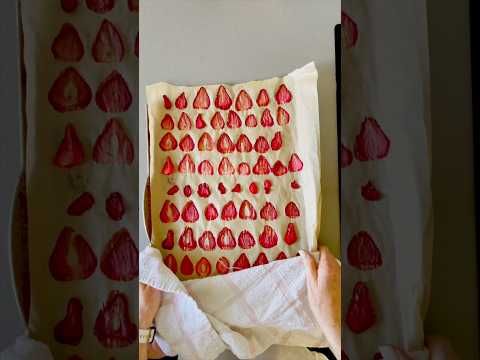Dehydrating strawberries in the oven is an easy and effective way to preserve the sweet, juicy flavor of fresh strawberries. Not only does it extend their shelf life, but it also concentrates their natural sweetness and intensifies their flavor. The amount of time it takes to dehydrate strawberries in the oven will depend on a few factors, including the size and thickness of the fruit as well as the temperature setting of your oven. In this article, we’ll discuss how long to dehydrate strawberries in an oven and provide tips for getting the best results.The amount of time it takes to dehydrate strawberries in an oven depends on several factors, including the size and thickness of the strawberries, the temperature of the oven, and how dry you want them to be. Generally, it will take 3-4 hours to dehydrate strawberries in an oven set to 140°F/60°C. You should check them periodically for desired doneness.
The Benefits of Dehydrating Strawberries
Dehydrating strawberries is a great way to preserve them and enjoy their flavor year-round. Not only is the process of dehydrating strawberries simple, but there are also many benefits to doing so. Dehydrating fruits, vegetables, and other foods can help you cut down on your grocery bill while also providing you with nutrient-rich snacks that are easy to store and transport. Here are some of the benefits of dehydrating strawberries.
One of the biggest benefits of dehydrating strawberries is that it helps to preserve their nutritional content. When fruits and vegetables are dried, they lose some of their water weight but retain most of their nutrients. Strawberries are an especially nutrient-rich fruit, containing high levels of Vitamin C, fiber, antioxidants, and other beneficial compounds. By dehydrating them you can enjoy these health benefits year-round without sacrificing flavor or nutrition.
Another benefit of dehydrating strawberries is that it helps them last longer than if they were kept in the fridge or on the countertop. The process removes moisture from the berries, making them shelf-stable for up to a year when stored in an airtight container in a cool, dark place. This allows you to buy larger quantities when they’re in season and store them for later use without worrying about spoilage.
Finally, dehydrated strawberries make for a great snack on the go! They’re lightweight and don’t require any refrigeration or heating up before eating. You can simply grab a handful whenever you need a quick burst of energy or if you want something sweet without having to go out for ice cream or candy bars. Plus, since they’re low in sugar and calories compared to most snacks, you don’t have to worry about overindulging!
Food Preparation
When it comes to food preparation, it is important to plan ahead. Make sure you have all the necessary ingredients on hand and that you know how to prepare them. Consider any dietary restrictions or allergies your guests may have, and plan accordingly. If you are making a dish for the first time, try it out beforehand to make sure it is up to your standards. It is also a good idea to have some quick and easy appetizers or snacks available in case your main dish is taking longer than expected.
Cookware and Utensils
Having the right cookware and utensils can make food preparation much easier. Make sure you have everything you need before you start cooking. You will need pots, pans, kitchen knives, cutting boards, spatulas, ladles, and other utensils depending on what dishes you are preparing. If you are short on certain items, borrow from family or friends or purchase them from a local store.
Serving Dishes
If you plan on serving food at your gathering, make sure you have enough dishes for everyone. Consider using disposable plates and utensils if there are not enough dishes for everyone. This will help reduce clean up time afterwards as well.
Decorations
Think about how you want to decorate your gathering space before the event begins. This could include flowers, table settings, centerpieces or other decorations that will help set the mood for the evening. You could also create a playlist of music that all of your guests can enjoy.
Dehydrating Strawberries: Step-by-Step Instructions
Dehydrating strawberries is an easy way to preserve them for long-term storage. This process will help keep your strawberries fresh and tasty for up to a year. By following these simple steps, you can enjoy your dried strawberries all year long.
First, start by washing and drying the strawberries. Make sure they are completely dry before proceeding with the next steps. If there is any moisture left on the strawberries, it can cause them to spoil faster.
Second, cut the strawberries into slices or chunks, depending on how you want them to look when they are done dehydrating. Slice them as thinly as possible for a crunchier texture or leave them thicker for a chewier texture.
Third, place the slices of strawberry onto dehydrator trays lined with parchment paper or use a baking sheet if you don’t have a dehydrator. Make sure none of the pieces are touching each other so that they can dry evenly.
Fourth, set the dehydrator temperature to 135°F and let it run until the strawberries are completely dry and crisp – usually about 8-10 hours, depending on how thickly sliced they were and how powerful your dehydrator is.
Fifth, once the strawberries are dried out completely, let them cool before storing in an airtight container in a cool dry place for up to one year. Enjoy!
Dehydrating Strawberries in Oven
Dehydrating strawberries in the oven is a great way to preserve their flavor and texture for later use. It’s also an easy process that can be done in a few simple steps. Here are some tips to help you get started:
1. Start with fresh, ripe strawberries. Make sure they are clean and free of any debris or mold.
2. Slice the strawberries into thin pieces, around 1/4 inch thick, and lay them out on a baking sheet lined with parchment paper.
3. Preheat your oven to the lowest temperature setting, typically around 150-200 degrees Fahrenheit. This will help ensure that the berries dry out evenly without burning or becoming too crispy.
4. Place the baking sheet in the oven and bake for 2-3 hours, or until the strawberries are completely dry and slightly crispy to the touch.
5. Remove from oven and allow to cool completely before storing in an airtight container or jar for up to 6 months.
Dehydrating strawberries in your oven is a simple way to preserve their flavor and texture for later use. With just a few simple steps, you can enjoy your favorite berries all year round!

Temperature Recommendations
When cooking, it is important to use the right temperature for the best results. Depending on the type of food, temperature recommendations vary. For example, when cooking proteins such as poultry or fish, it is recommended to cook at a higher temperature (around 375 to 425 degrees Fahrenheit) to ensure that they are cooked through. When baking items such as cookies or cakes, a lower temperature (around 350 degrees Fahrenheit) is recommended in order to prevent burning. Additionally, when roasting vegetables or meats, an even higher temperature (around 450 degrees Fahrenheit) is recommended for optimal results.
Time Recommendations
In addition to selecting the right temperature for your cooking needs, it is also important to select the right amount of time for best results. Again, this will vary based on the type of food being cooked. For proteins such as poultry or fish, it is recommended to cook them for around 15-20 minutes in order to ensure they are cooked through and safe to eat. When baking items such as cookies or cakes, it is typically recommended that they be baked for around 10-15 minutes in order to prevent burning while still achieving desired results. Lastly, when roasting vegetables or meats, they should typically be roasted for around 30-40 minutes at the higher temperatures mentioned earlier in order to achieve desired results.
Signs of Properly Dehydrated Strawberries
When dehydrating strawberries, it is important to ensure that they are properly dehydrated. Poorly dried strawberries can spoil quickly and end up being a waste of time and money. There are several signs that you can look for to determine if your strawberries have been adequately dehydrated.
The first sign of properly dehydrated strawberries is that they will have a leathery or brittle texture. The fruit should be hard and not easily crushed when pressed with your fingers. If the strawberries are still soft, then they need more time in the dehydrator.
Another sign of properly dehydrated strawberries is that they should be pliable but not sticky. If the fruit feels sticky or tacky to the touch, then they have not been dried out enough and need additional time in the dehydrator before storage.
The color of the fruit is also an indicator of proper dehydration. Once fully dried out, the strawberries should be a deep red hue with no hint of green remaining on them. If any part of the strawberry has a green tinge to it, then it has not been adequately dried out yet.
Finally, properly dehydrated strawberries should feel lightweight when you pick them up and hold them in your hand. The fruit will have lost most of its moisture content during dehydration and as a result will be much lighter than when originally picked from the plant.
Storing the Dehydrated Strawberries
Dehydrated strawberries are a delicious snack, but if you want to store them for later use, there are a few things you should consider. First, it’s important to keep the fruits in an airtight container. If the container is not airtight, moisture will get in and the strawberries will spoil. To ensure optimal freshness and flavor, make sure to seal the container tightly.
It’s also important to store your dehydrated strawberries in a cool, dry place. Heat and light can cause the fruits to spoil quickly. Avoid storing them in direct sunlight or near any heat source such as a stove or radiator.
Finally, it’s best to consume your dehydrated strawberries within two weeks of opening the container. After two weeks, the flavor and texture of the fruits will start to degrade and they may no longer be safe to eat. To ensure maximum freshness and safety, it’s best to consume all of your dehydrated strawberries within two weeks of opening the container.

Conclusion
The process of dehydrating strawberries in an oven is relatively simple and straightforward. It requires minimal time and effort and can be done with basic kitchen equipment. The main considerations when dehydrating strawberries in an oven are temperature, duration, and ventilation. The ideal temperature for dehydrating strawberries is 135-145°F (57-63°C) and the duration can range from 8-12 hours, depending on the desired result. It is also important to ensure sufficient ventilation to ensure that moisture can escape from the oven. With these tips in mind, you can be sure to get delicious dried strawberries that will last for months!
Overall, dehydrating strawberries in an oven is a great way to preserve them for longer periods without having to worry about them going bad quickly. Not only does it save time and money, but it also allows you to enjoy the taste of fresh strawberries all year round!



